Children are full of surprises. One minute they’re laughing and running around. The next, they’re crying because their stuffed animal said something “mean” to them.
As a parenting professional, you know how to raise kids without pulling out your hair. Some people may even call you the “child whisperer.”
You have the tools for the job, but are you struggling to find clients? How do you communicate with your audience about your parenting tips and tricks? What’s the best way?
Enter: a parenting style quiz.
A parenting style quiz is the answer to engaging with potential clients, growing your email list, and booking yourself solid.
In this post, I’ll teach you everything you need to know about parenting quizzes, including:
- What a parenting style quiz is
- The four parenting styles
- How to create a quiz with Interact
- Email list building
- How to ask good questions
Does this sound up your alley? Great! Let’s get started.
What is a parenting style quiz?
Before I define a parenting style quiz, let’s talk about parenting styles. What are they, anyway?
A parenting style is how you discipline your children. Your dominant parenting style can affect a child’s overall behavior patterns.
So a parenting style quiz tells you what style you use the most and why.
There are four parenting styles: authoritarian, authoritative, permissive, and uninvolved. We’ll go over these soon. But first, I’ll answer the question you’re probably wondering right about now: Why should I create a parenting style quiz in the first place?
Why create a parenting style quiz?
A parenting style quiz is perfect for anyone in the family, psychology, and child development industries, like parenting bloggers, coaches, and therapists.
I bet you’ve heard clients say, My kids aren’t behaving the way I want them to or My kids won’t listen to me.
A parenting quiz will help your clients understand:
- Their behavior as a parent
- How their behavior affects their children
- An intro to developing a healthy parenting style
Plus, your quiz opens the gate to your content, email list, and online courses. When you jam-pack your quiz with value, parents will be dying to learn about your services.
But let’s not get ahead ourselves. First, let’s go over the parenting style theory and each style.
What’s the parenting style theory?
Ever wonder why children behave differently from one another? Some kids are angels, and others are, well, the opposite of angels.
Diana Baumrind, a developmental psychologist, thought of a framework to explain why kids behave differently from one another.
Back in the 1960s, Diana observed a few preschoolers and thought, All of these preschoolers act with certain behaviors. I wonder why.
Diana theorized that our parents strongly influence our behavior as children. And after extensive research and interviews, she came up with three different parenting styles.
- Authoritative
- Authoritarian
- Permissive
Fast forward to the 1980s—psychologists Maccoby and Martin split the permissive style into two. Thus, the uninvolved parenting style was born.
So now there are four different parenting styles.
- Authoritative
- Authoritarian
- Permissive
- Uninvolved
Let’s explain each of these, shall we?
What are the four types of parenting styles?
As you read each parenting style, remember that all of them have their pros and cons. We’ll get started with the authoritative parenting style.
1. Authoritarian parenting style
If the authoritarian parent were an archetype, they’d be the ruler. Authoritarian parents believe rigid rules are the best way to raise their kids.
Some might describe the authoritarian as strict, controlling, and a bit scary. As parents are the authority in a parent-child dynamic, they believe their children should obey every command.
We’ll use the “Can I hang out with my friends?” scenario to describe an authoritarian.
Lily is 14 years old. She’s a straight-A student and always turns in her homework on time. Her mother, Martha, makes sure Lily finishes her homework every day. She also signed Lily up for two extracurricular activities—piano and soccer.
Last Thursday, Lily’s friends invited her to a football game. Usually, Lily would politely decline—there’s no way her mom would let her go to a football game on a school night. But she finished all of her homework at school, AND her piano lesson was canceled.
Maybe she’ll allow it this ONE time, Lily thought.
When Lily came home, she asked her mom about the football game: “I finished my homework and my piano lesson was canceled today! The football game will be over by 9:00 pm. My bedtime isn’t until 10:00. Can I go, pleaseeee?”
Her mom started laughing. “You think I’d let you go to a football game on a Thursday night? Definitely not. Besides, just because your piano lesson is canceled doesn’t mean you can’t practice at home. In fact, why don’t you go start right now?”
“But mom,” Lily pleaded, “I haven’t gone to one football game this year. And my piano teacher says I’m way ahead of the other students. Can I go this one time?”
“Lily, if you ask me to go to the football game again, you’re grounded.” Lily’s mom rolled her eyes. “I don’t want to hear it anymore; no means no. Now please go practice piano.”
As you can tell, authoritarian parents don’t care what their children say. Whatever they say goes.
And no, this doesn’t mean authoritarian parents are “evil” or “heartless.” They only want the best for their children and will show it with orders and unbendable rules.
The pros of an authoritarian style are:
- Creates defined boundaries for children
- Teaches children to respect and listen to the rules
And the cons:
- Doesn’t allow kids to think for themselves
- Kids will only listen to their parent because they are scared, not because they want to
2. Permissive parenting style
Permissive parenting is the opposite of authoritarian parenting. You can think of the permissive parent as the “best friend.”
You could describe this style as hip, relaxed, and fun. As long as their kids are happy, they’re happy!
Let’s use a similar scenario to describe a permissive parent.
One month ago, Johnny begged his dad, Nathan, to sign him up for guitar lessons: “I promise that I’ll practice every single day!”
Nathan wasn’t convinced at first. Johnny has quit every hobby he’s tried. But he doesn’t want to stop Johnny from learning guitar. Maybe he’ll stick with it this time, Nathan thought.
So Nathan signed Johnny up for guitar lessons and even bought him a used guitar!
After a few weeks, Nathan noticed Johnny’s lack of motivation. “Johnny, didn’t you tell me that you were going to practice every day?”
“Ugh. The guitar is boring now. I want to join something else, like the drums! Can I do that instead, Dad? I promise I’ll like the drums!”
Nathan hesitated. “But I already bought you a guitar, Johnny. Are you sure you don’t want to play?”
“No, Dad.” Johnny squinted. “I told you that the guitar is boring. I don’t want to play anymore.”
Nathan felt disappointed in Johnny. But at the same time, he didn’t want to make him do something he hated.
“Well, if you don’t like it that much, then I guess you can quit. I’ll find something to do with this guitar,” Nathan replied.
“Thanks, Dad. You’re the best!” Johnny exclaimed, and Nathan smiled and hugged his son.
It’s easy for permissive parents to let their kids do what they want. Nathan wanted his son to continue playing guitar but didn’t have the heart to discipline him—a common trait for permissive parents.
All in all, this style wants their children to be happy. And they’ll say and do almost anything to make that happen.
The pros of a permissive style include:
- Allows kids to make decisions
- Loving and nurturing toward children
And the cons:
- No boundaries can lead a child to act out
- Children may have trouble making the right decisions later on
3. Uninvolved parenting style
Did you ever have that friend who said, “Come over! My parents are never home!” They probably had an uninvolved parent.
Uninvolved parents don’t show interest in their children’s lives. They don’t respond to positive or negative behaviors, like getting straight As or ditching school. They just don’t care.
This parenting style is self-absorbed, dismissive, and neutral. They’re too “busy” with other tasks to focus on their children’s lives.
Here’s what an uninvolved parent looks like.
“Hey, Mom!” Danny said on the phone. “I have a huge basketball game tomorrow. Are you going to come?” Danny hadn’t heard from his mom in a couple of days. She’s so busy with her real-estate business and basically lives at work.
“Hi, honey! What time is it at? You know I have a big housing tour tomorrow,” Danny’s mom responded with a client on the other line.
“Oh, yeah. Well, it’s at 7:00 pm. Can’t you swing by for a little?” Danny asked.
“Sorry, honey. I don’t know if I’ll make it. Also, I’m not going to be home for dinner. I left some money on the counter—order pizza or something. Gotta go, bye!” She hung up before Danny could even say bye.
Bye… Mom, Danny thought.
It’s easy for an uninvolved parent to dismiss their child’s activities, like a sports game. They believe their kids are independent enough to go through life on their own.
The pros of an uninvolved parent are:
- Allows children to make their decisions
And the cons:
- Kids don’t feel safe and cared for
- Kids may grow up with emotional issues
4. Authoritative parenting style
Last is the authoritative style. You can think of this style as the leader—they set rules and routines for their children but allow flexibility and discussion.
Most would describe an authoritative style as understanding, stern, and supportive.
So what does an authoritative parent look like?
Paula is entering the 7th grade. Now that she’s 13 years old, Paula believes her bedtime should be 10:00 pm instead of 9:00 pm.
“Hey, Dad. Now that I’m in the 7th grade, I think my bedtime should be at 10:00 pm instead of 9:00 pm.”
“Now, Paula,” says Ulises, her dad. “Your bedtime has always been at 9:00 pm. Why do you want to change it now?”
“Well, my softball team changed our practices to 7:00 pm. And I know I’m going to have more homework this year.” Paula replies and shows him her softball schedule.
“Good point, Paula,” her dad responds. “Plus, you’ve always been good about your bedtime. Why don’t we start at 9:30 pm and then check back in a couple of months? If all goes well, I’ll change it to 10:00 pm.”
“Okay. I guess that works for now!” Paula says.
The authoritative style always has the last say, but they hear their kids out. Open discussion is a priority for this style.
The pros of an authoritative style are:
- Allows their kids to state their opinions and feelings
- Empathizes with children’s needs
- Sets strict rules without going overboard
And the cons:
- Parents with this style can often shift toward permissive or authoritarian if they aren’t careful. Consistency is key.

What parenting style is best for a child’s future?
Most experts would agree that the authoritative parenting style is the best. Authoritative parents set boundaries yet allow their kids to make independent decisions. Plus, they tune into their children’s emotions and needs.
This doesn’t mean the other styles are terrible. But they can lead to misbehaved children down the line.
A few things to keep in mind about the styles:
1. Parents aren’t consciously aware of their styles
Most of us use past experiences to raise our kids. For example, if you grew up with an authoritarian parent, you might show a few authoritarian traits.
2. Authoritative parenting only works with balance
The authoritative style is a healthy mix of authoritarian and permissive. It’s easy to tip one way or the other, so balance is crucial. Some situations need strict parenting, while others need laid-back parenting.
All in all, awareness is key to developing a parenting style. And guess what?
You can use your parenting style quiz to spread awareness! Once your audience knows their style, they can use your tools to learn and develop into well-rounded parents.
Other parenting quiz ideas
You might be wondering, Do I HAVE to use a parenting style quiz for my clients?
Of course not! While the parenting styles are a good guideline, you can mix it up to fit your brand.
Be Kind coaching is a good example. They promote their coaching services with a “How kind is your family?” quiz.
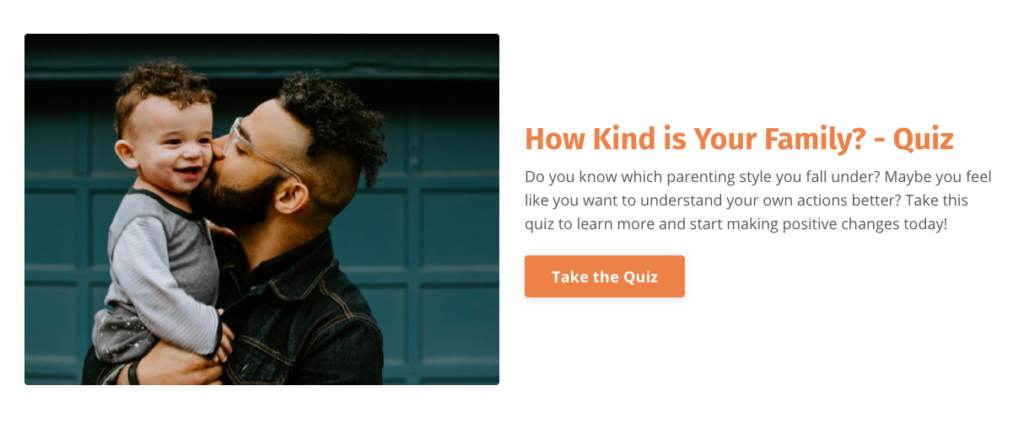
Be Kind uses the parenting styles as a base, but they added “kind” to fit their brand. Some questions they ask in their quiz are:
- While making dinner, your child tells you that they will not be eating that “yucky stuff.” What’s your go-to response?
- Your child brings home an “F” on a big test, you…
- How easy are your mornings?
Sarah Rosensweet is another example. Sarah is a parenting coach. She created a “What’s your parenting superpower?” quiz to introduce her services.

I like this quiz because it’s positive and encouraging. Who wouldn’t want to know their superpower?
Some questions Sarah asks are:
- How do you want to feel as a parent?
- Your child is crying loudly over Fruit Loops at the grocery store. Do you say…
- Your child is hitting their sibling with a toy. You tell them…
And last is Coach Franny. Coach Franny uses the parenting style theory but adds her twist with a “Which parent are you?” quiz.
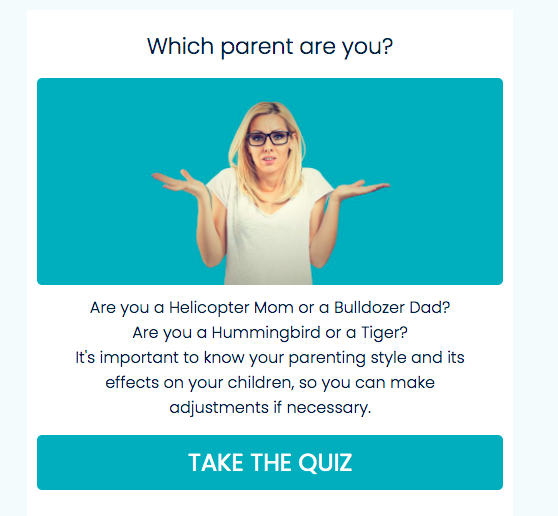
She uses lingo like “Helicopter mom” or “Bulldozer dad” to make her quiz more unique. Some questions Coach Franny asks are:
- Your child says, “I hate you,” you say…
- How do you handle conflict with your child?
- How do you show your child love?
As you can see, there are many ways to create a parenting style quiz. With that, let’s get to quiz-making!
How to create a parenting style quiz with Interact
As a quiz-making software, we have everything you need to create the perfect parenting quiz AND get more clients.
Some of our features include:
- Conditional logic
- Quiz design
- Hundreds of quiz templates
- Analytics
- An email opt-in
- Social sharing
And more! If you haven’t already, create an Interact account to follow along with the tutorial.
Table of contents
- Create a quiz
- Design
- Create the cover page
- Choose your questions
- Build the results page
- Correlate results
1. Create a quiz
On your dashboard, click Create New Quiz.

You’ll see a list of templates. You can either start from scratch or choose any of our templates. We’ll use the “What’s your parenting style?” template in this tutorial.

Now let’s get to the fun part—design!
2. Design
It’s easy (and fun!) to design your quiz with Interact. To choose your colors, font, and logo, head to the Quiz Colors menu at the top.

You can either keep the template color scheme or choose one to match your brand.
Click on T to change your font; click the photo icon to upload your logo to the bottom right corner of your quiz. Adding your logo will promote your business without being too flashy. Plus, it will keep others from stealing your quiz.
These tips help you with the overall design of your quiz, but what about your cover page and questions?
We’ll get to those in the next few steps.
3. Create the cover page
Your cover page consists of three elements: the title, description, and call to action.

Remember, the cover page is the first thing your audience sees. It should speak directly to them.
The title can be straightforward. Something simple like, “What’s your parenting style?” is fine because it includes the word “parent.”
Next, tell your audience what your quiz is about with a one- to two-sentence description. Many of our customers:
- Add a timestamp like “Take this 60-second quiz!” to promote a fast and easy quiz.
- Share the possible results quiz-takers can get, like “indulgent, hands-off, balanced, or strict” above.
- Include what’s in it for the quiz-taker. This can be a free resource, like an e-book or audio recording.
Last is the call to action. You can keep it simple, like “Take the quiz” or choose something personable like:
- Learn your parenting style
- Find out what your children need
- Take the 60-second quiz!
4. Choose your questions
You can use the template questions or create your own with the “Ask thoughtful questions” section in this post.
Now, let’s get back to the design.
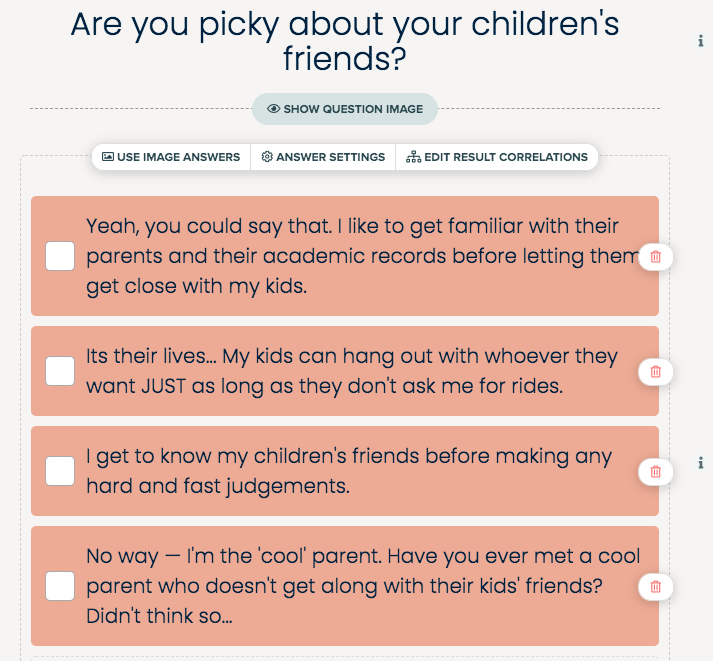
Sure, your questions and answers are important elements of a question. But you can also use images to make your questions more interesting.
To change your images, click on Show Question Image.

Then click Edit to change your photo.
Another way to add images is with Image Answers.
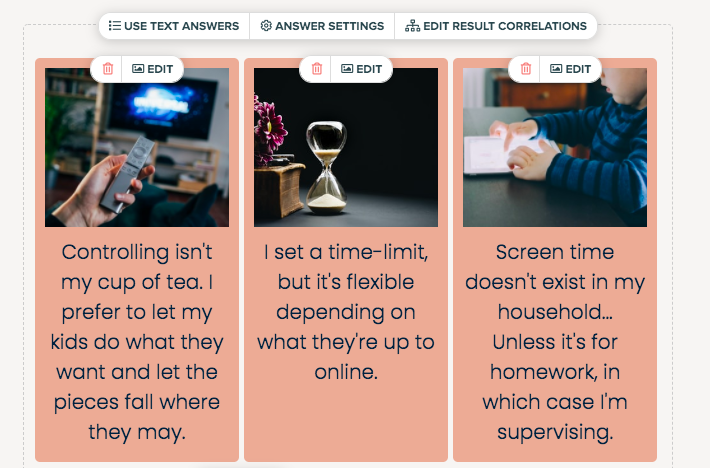
Image answers help your audience understand each answer with more detail. Plus, they look pretty.
As for multiple-choice answers, you can allow your audience to choose more than one answer with Select Multiple Answers.

We’ll worry about your result correlations later. But first, let’s design your result pages.
5. Build the result page
Your result pages are crucial when it comes to your audience. Each result page should resonate with your quiz-takers. Make them feel seen and heard.
You can do this by:
- Describing each result in full-detail
- Adding value, like free resources
- Introducing yourself and your business
I’ll walk you through each part of the results page.

Always state your quiz-taker’s results at the top of the page. And avoid using a negative tone. You want your audience to feel positive about their results.
Now let’s talk about the description. Your description contains three elements: a description (obviously!), the problem, and a solution.

Describe the user’s parenting style at the beginning. Your quiz-taker should be thinking, Wow, this is totally me!
As you describe your user’s parenting style, introduce the problems they have. Sympathize with their struggles with “I see you” or “I know where you’re coming from.”
Last, push your audience in the right direction with a solution. And you can add a few more tips and tricks like below.
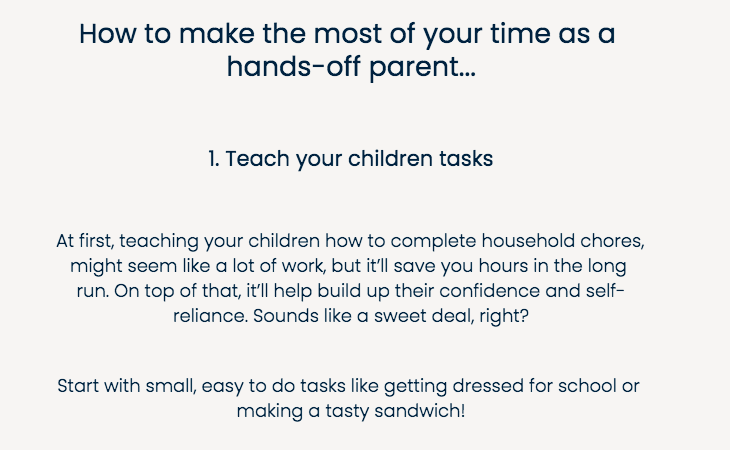
Now that your audience is packed with knowledge, introduce yourself and what you do.
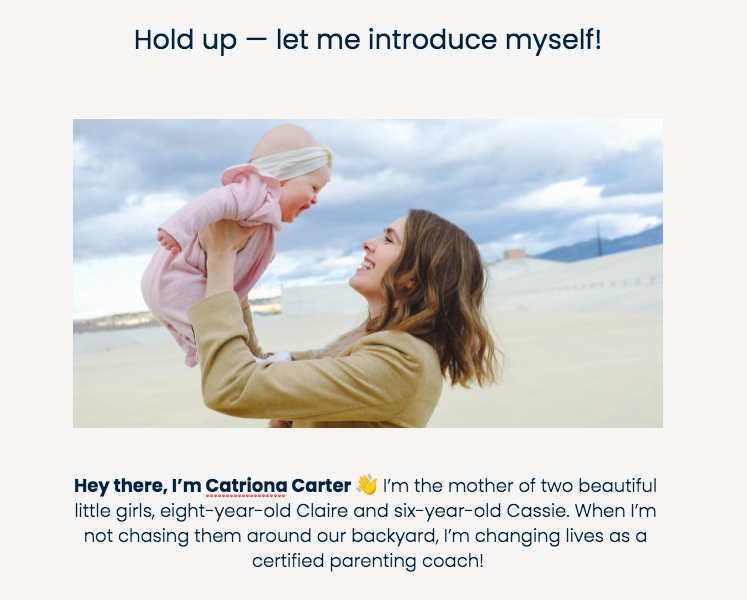
Tell them how you relate to them as parents and introduce your product or service.
Notice how the intro above says, “I’m the mother of two beautiful little girls, eight-year-old Claire and six-year-old Cassie.”
Talking about your experience or children helps your clients connect with you as a parenting coach.
At this point, your audience knows:
- Their parenting style
- How to develop their style
- About you and your services
Now is the perfect time to offer even MORE resources. Your free content will come in handy.
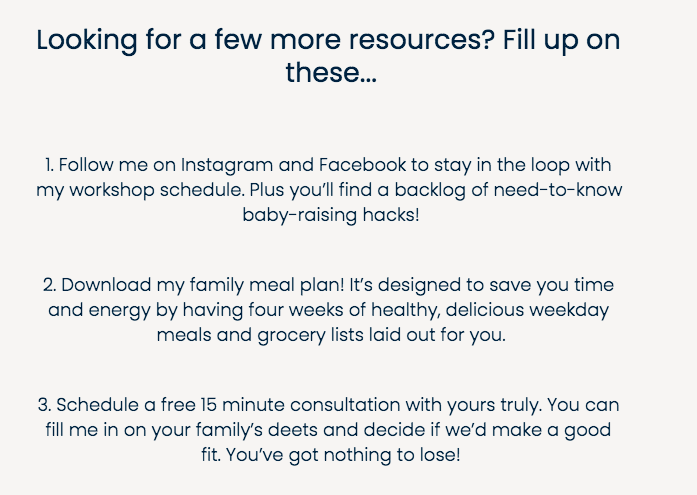
Some free resources you can offer are:
- Downloadable templates
- An audio recording
- A consultation call
- Your podcast
- An e-book
And the list goes on. Don’t forget to add a quick call to action at the bottom.

Let your audience know you’ll be popping in their inbox from time to time. And voila! Your results page is done!
6. Correlate results
Now we can correlate your questions with your answers. So when a user selects an answer, our software will connect that answer with a certain result.
Head back to your questions and click Edit Result Correlations.

Then correlate each answer with a result. Make sure to correlate every question with your results.

When you’re done, hit the eye icon at the top to preview your quiz.

If you like what you see, hit Publish! And that’s it. Your parenting style quiz is officially done.
So what’s next?
Optimize your parenting quiz with email
If you’ve read our case studies, then you know how a quiz can boost your email list like CRAZY.
Leisa Peterson from Wealth Clinic generated 7,000 new email subscribers with an Interact quiz! If you’re thinking, Wow, I wish this was me—well, it can be you.
But there are a few things you need to do first, like create an email opt-in form. An email opt-in form asks users to exchange their email address for their quiz results.
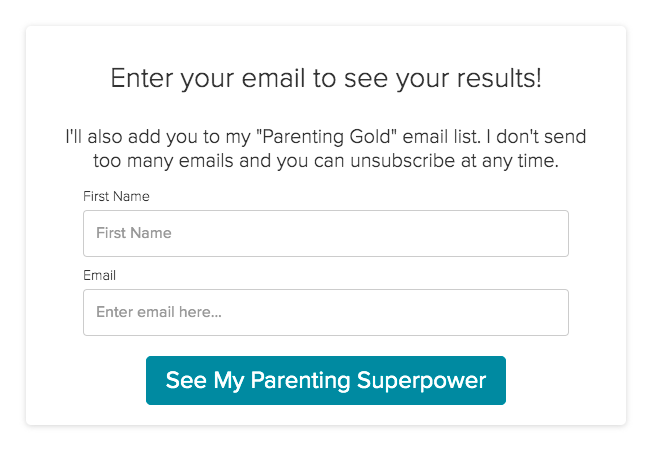
To create an opt-in, head to your quiz dashboard and toggle on Lead Generation.
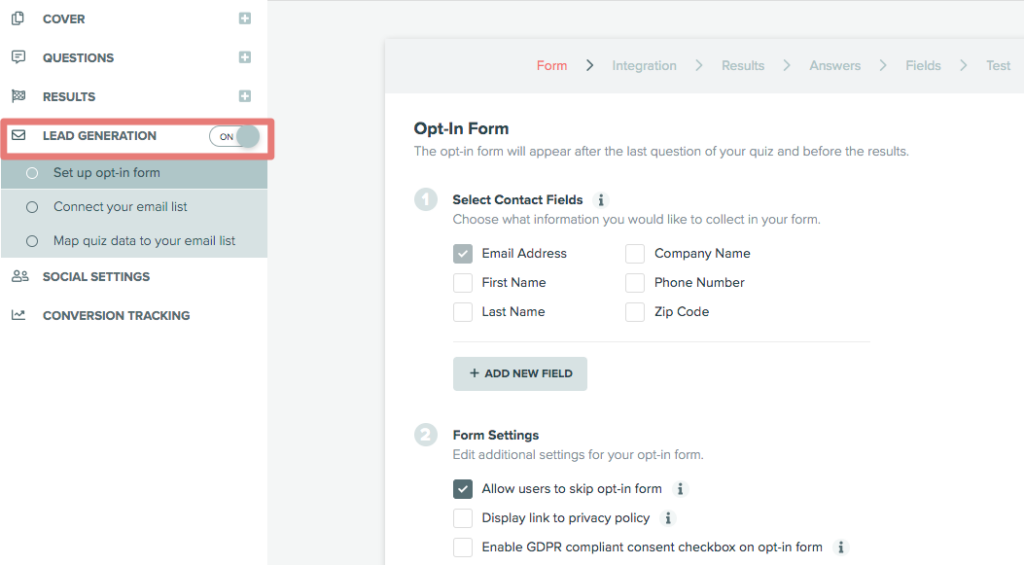
Under Select Contact Fields, choose what info you’d like to collect. Most businesses only need a first name and email address.
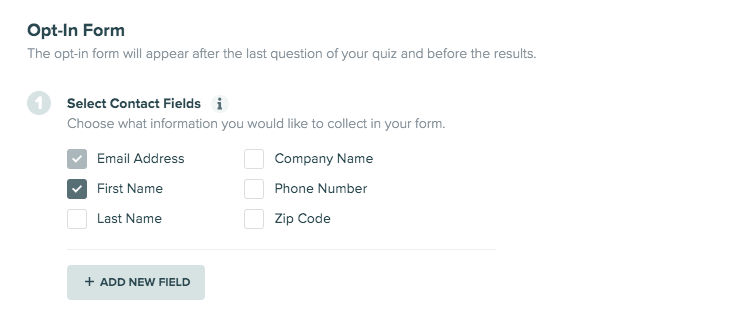
Next is Form Settings.

These settings are optional. But we suggest allowing your audience to skip your form. This way, people who are interested in their results will follow through.
And last is Edit Form Content, where you can customize your email opt-in form.
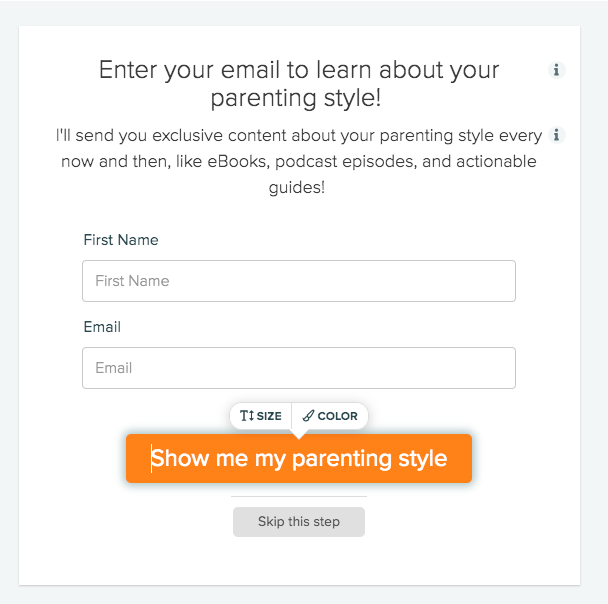
Your email opt-in is one giant call-to-action. Get your audience excited about their results and free content with a description. Tell your audience everything they get when they sign up for your email list.
When you’re finished, click Save and Continue to integrate Interact with your email marketing software.
Some resources you’ll find helpful in the following steps are:
- How to Build an Email List Using Quizzes
- How to Write the Perfect Followup Email Sequence
- The Complete List Building Guide
Create content about parenting styles
Have you ever thought about segmenting your email list?
Segmentation means separating your email list into different groups. These groups will be determined by your quiz-takers’ results.
So the authoritative parenting style would receive content tailored to authoritative styles, and so on.
So why should you segment your email list?
Segmentation personalizes your content. If an authoritarian style receives content about permissive parenting, they won’t relate, right?
But if an authoritarian reads content about their style, they’ll feel understood and connected with your business.
The first step to segmentation is free content. What content can you create for each parenting style?
Here are a few ideas:
An e-book—Get in-depth with each parenting style with an e-book. Explain strengths, flaws, and ways to improve.
A video—Create a few videos talking about each parenting style. Compare and contrast each type, and describe what each looks like in a parent-child relationship.
Blog posts—There’s no need to create new content on your blog. Repurpose your videos into blog posts, or vice versa.
Podcast episodes—Everyone’s listening to podcasts these days. Create a series about each parenting style. If you can, interview a few of your clients and talk about their experience as X.
You can learn more about segmenting your email list with our guide: How to Power up Your Market Segmentation Strategies for More Leads and Revenue.
Ask thoughtful questions
A quiz with bad questions won’t get very far. Thoughtful questions will inspire your audience to finish your quiz to see their results.
So what makes a thoughtful parenting quiz question? Let’s take a look at three important factors.
1. Relatable
You know what they say. When you become a parent, your entire life changes. So it’s important to ask parents questions they’ll resonate with.
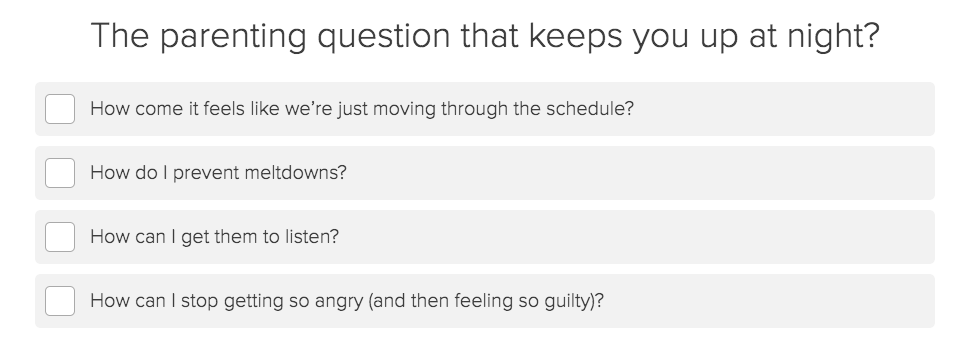
Unless you’re a perfect parent (newsflash: nobody is!), then there’s always something you want to improve with parenting. So the question, “The parenting question that keeps you up at night?” relates to all styles.
Here are a few more relatable questions you can ask:
1. If you could wave a wand, what to-do list item would you banish?
- Cleaning the house—it gets dirty so quickly!
- Picking up the kids from school—it disrupts my workflow.
- Dealing with tantrums. Sometimes I wish my kids had a mute button.
- Laundry—SO MANY CLOTHES!
2. How did you react when your child threw their first tantrum?
- I didn’t know how to respond, so I just ignored it.
- I gave them a time-out. They will never get away with tantrums.
- I hugged them and asked what was wrong.
- I told them I wouldn’t respond until they talked to me in a better tone.
3. What best describes your dinner routine?
- Take-out. I don’t have time to cook. And besides, the kids LOVE pizza.
- We sit down as a family to eat every night.
- I wish my kids would help me cook, but they usually end up watching TV.
- I leave some money on the counter and tell the kids to order take-out. I’m usually working late!
2. Scenario
The best type of questions to ask in a parenting quiz are scenario questions. Scenario questions start with sentences like:
- “Would you rather…”
- “What would you do if…”
- “You and your kids…”
Parents have a lot on their plate, like working and going to school events. They deal with crazy scenarios ALL the time!
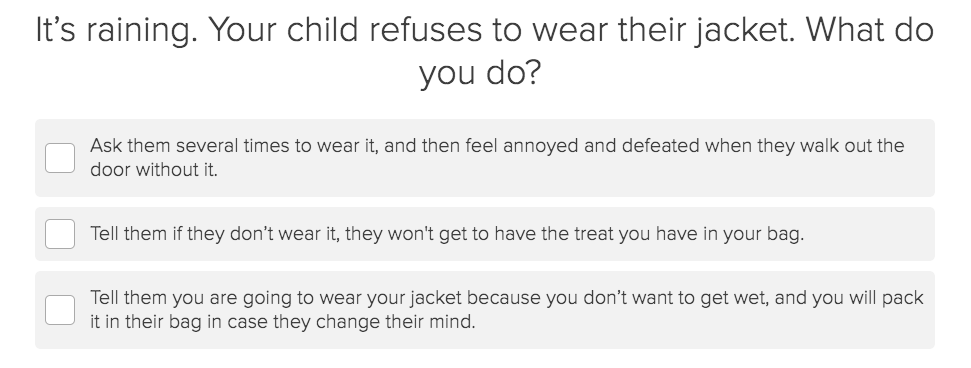
I remember refusing to wear a jacket as a kid. So I know the scenario above speaks truth to all parents out there.
Keep reading for a few examples of scenario-style questions.
1. When you pick up your child from school, they tell you they got an A on their test. What do you say?
- You’re amazing! Let’s grab some ice cream as a treat.
- Great job! Let’s make sure you get an A+ next time!
- That’s nice, but it doesn’t get easier from here, so keep working hard!
2. Your child asks if they can go to a soccer game on a school night. What do you say?
- Yeah, sure! Do you need a ride?
- I don’t mind, as long as you can get yourself there and back.
- A school night? No way. You have to go to bed early.
- You can go this one time, but I don’t want to make this a regular thing.
3. You and your kids have the day off! What do you do?
- Go to the park and play games! Maybe if they run around enough they’ll get tired.
- Take your kids to lunch and a movie.
- Tell my kids they can do whatever they want and take some ME time for myself.
- Stay at home and finish some chores. The house is a mess!
3. Good answers
The counterpart to a question is the answer. When it comes to a parenting quiz, make sure your answers correlate with every parenting style.
To refresh your memory, the parenting styles are:
- Authoritative—the “leader”
- Authoritarian—the “ruler”
- Permissive—the “best friend”
- Uninvolved—the name speaks for itself
Remember that you can create your results if you want. But the point is to connect your answers with your results.
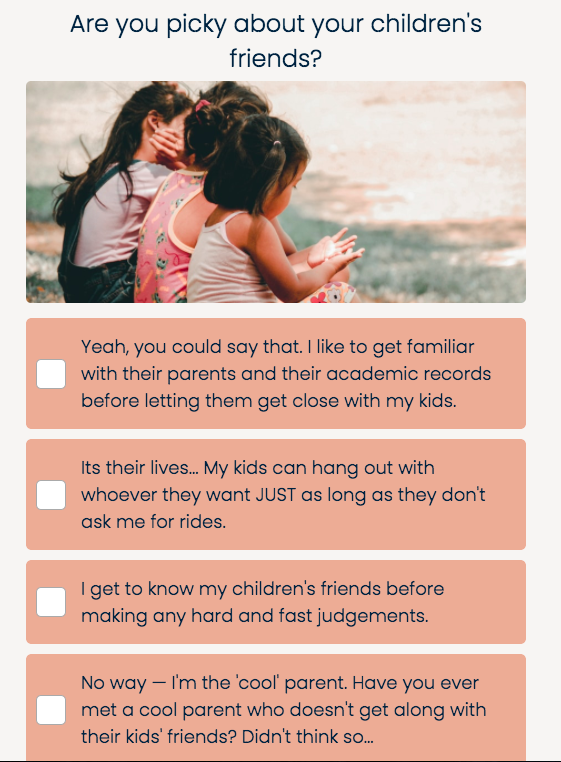
The question, “Are you picky about your children’s friends?” includes answers from all parenting styles.
Let’s go over each answer.
“Yeah, you could say that. I like to get familiar with their parents and their academic records before letting them get close to my kids.”
Checking academic records sounds a bit like authoritarian parenting, right?
Let’s look at the next one: “It’s their lives… My kids can hang out with whoever they want JUST as long as they don’t ask me for rides.”
Disengaging from your children’s friends is a bit uninvolved.
The third answer, “I get to know my children’s friends without making any fast or hard judgments,” is balanced, like authoritative parenting.
And last, the whole “No way—I’m the COOL parent” thing is permissive to the T.
Here are a few more questions with answers tailored to the parenting styles:
1. What’s your biggest WIN as a parent?
- When my kids do what I say without any “ifs” or “buts.” (authoritarian)
- When my child opens up to me about their lives. (permissive)
- When I take my kids to school, extracurricular activities, and errands without any tantrums. (authoritative)
- When I don’t have to partake in any child-related activities for the day! (uninvolved)
2. What’s your least favorite thing about being a parent?
- Nothing really. I still go about my life with or without my kids. (uninvolved)
- Telling my kids what to do. I avoid it when I can. (permissive)
- Ordering my kids around all day and all night. Why don’t they just get it? (authoritarian)
- I love it all, but if I had to choose, it’d be working and parenting all day long. (authoritative)
3. You walk into your child’s room at night and find a bunch of pillows in their bed. It looks like they sneaked out! How do you react?
- Send them a text and say, “I know you’re not in the house. Please come home safely, and we’ll talk about it later. Or, let me know if you need a ride.” (authoritative)
- Text them an angry message and drive to every spot you think they’re at. And when you find them, ground them on the spot. No “ifs” or “buts.” (authoritarian)
- Eh, kids will be kids. I’d let them do whatever they want. (uninvolved)
- Give them a call and tell them they don’t have to sneak out to have fun. Next time, you’ll let them hang out with whoever at whatever time! (permissive)
Your next steps: promote your parenting style quiz!
And we’re at the end! At this point, you’ve:
- Learned the parenting styles
- Created a parenting styles quiz
- Built an email opt-in
- Created thoughtful questions
So what are your next steps?
To promote your parenting quiz, of course! The best way to promote your quiz is with social media or embedding your quiz on your website. And don’t forget to let us know how successful your quiz is!